Industry’s Pollution Challenge and Our Real Solutions for Being a Good Neighbor
By Kelly Hile
Airflow Sciences is using our 45+ years of experience in reducing emissions to help plants comply with the EPA's Good Neighbor Plan.
The EPA’s newly adopted Good Neighbor Plan is bringing attention to methods of reducing pollution, especially for power plants, cement kilns, paper mills, and refineries. The combustion of coal or natural gas for power generation and industrial processes can have byproducts such as carbon monoxide (CO), sulfur dioxide (SO2), nitrogen oxides (NOx), VOCs and particulates. The EPA has regulated these pollutants since 1970. As the latest in these regulations, the Good Neighbor Plan aims to further reduce emissions, particularly targeting facilities whose emissions are predicted to end up in downwind states. The major industries affected by the rule – power generation, oil & gas refining, cement production, and paper manufacturing – have thousands of plants in operation in the United States today. Starting in 2023, these industries must reduce their emissions every year or they will face fines and potential shut-down of operations.
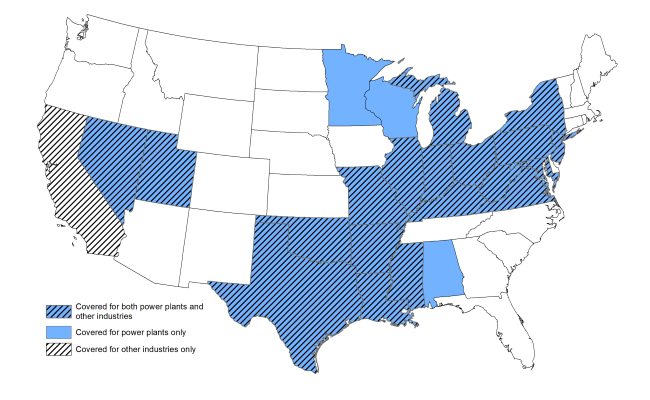
States Covered by the Good Neighbor Plan by Industry Type
Source: U.S. Environmental Protection Agency
Improving Plant Efficiency to Reduce Emissions
In order to reduce plant emissions, a company can employ one of two main strategies – efficiency or remediation. The first strategy focuses on the combustion process to produce more power or process heat while burning less fuel. Over the years, many process efficiencies and best practices have become standard in the industry. A finely tuned combustion process is a dual benefit to a plant, since it not only reduces emissions, but lowers input costs and improves profitability.
Efficiency Strategies:
- Low NOx burners and staged combustion techniques
- Boiler tuning / burner air and fuel balancing
- Managing air inleakage
- Fuel selection and preparation
- Waste heat recovery units (WHRU)
When all of these processes are working at their highest level of efficiency, pollution can be significantly reduced, all while making a plant money in reduced inputs or higher outputs. There are some common problems we see at coal-fired plants, such as inleakage and poorly balanced combustion air. Airflow Sciences provides both test equipment and flow modeling to help measure, monitor, and optimize coal pipe fuel balance, windbox secondary air and overfire air flows, and combustion system operation.
At plants burning natural gas for power or process heat generation, we see heat transfer losses due to non-uniform flow patterns, inadequate thermal mixing, and inconsistent burner performance. Airflow Sciences has helped improve the design of a variety of plant equipment involving these combustion and thermal processes, including Heat Recovery Steam Generators (HRSG), Regenerative Thermal Oxidizers (RTO), cement kilns, paper plant recovery boilers, WHRUs, rotary/tubular air heaters, and a variety of other shell-and-tube heat exchangers.
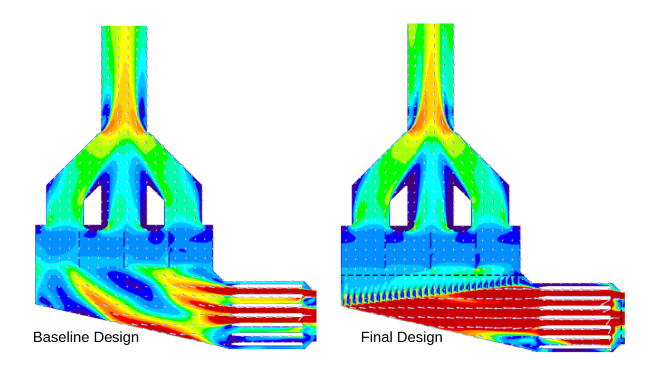
Computerized simulation of a WHRU as it evolves through the design process. The final design exhibited much more uniform flow and heat transfer to maximize production while minimizing fuel costs.
Reducing Emissions Through Remediation Strategies
The second strategy for reducing emissions involves dealing with pollution downstream from the combustion and production process. Industrial plants in the US have been using pollution control equipment for decades. These are technologies that aim to reduce or eliminate pollutants in the exhaust gas stream. Unlike efficiency improvements, these technologies typically don’t offer any sort of cost-incentive to a plant’s bottom line. Instead, plants invest a heavy amount of capital in massive systems that pull out pollutants prior to exhausting combustion products to the atmosphere.
Remediation Strategies:
- Selective Catalytic Reduction (SCR)
- Electrostatic Precipitator (ESP)
- Dry Sorbent Injection
- Baghouse/Fabric Filters
- Wet or Dry Scrubbers
- CO2 Capture and Sequestration
Pollution control systems like these reduce overall plant emissions, but they can be plagued by inefficiencies of their own, making them less effective in reducing pollutant concentrations.
Selective Catalytic Reduction (SCR)
In Selective Catalytic Reduction (SCR), ammonia is injected into the exhaust flue gas stream, initiating a chemical reaction that converts harmful nitrous oxides (NOx) into harmless molecules of plain nitrogen gas and water vapor with the help of a catalyst. However, these ammonia injection systems are prone to inefficient mixing, causing ammonia slippage. This happens because the ammonia is not distributed evenly across the exhaust flow stream or because flow velocity varies across the duct. As a result, a plant will end up emitting ammonia to the atmosphere along with any remaining NOx that failed to be converted.
The Good Neighbor Plan NOx reduction targets will require plants, especially those with older ammonia injection system designs (greater than 10 years), to enhance their injection and mixing systems. This constitutes a large percentage of the US coal-fired SCRs and nearly half of the gas turbine (simple and combined cycle) fleet. Airflow Sciences has a proven track record using both computer modeling and flow testing/tuning to help these SCR systems improve their NOx reduction while minimizing ammonia slip and usage.
For coal-fired SCRs, pluggage of the catalyst by Large Particle Ash (LPA) or fine ash material is an ongoing challenge for plants. The pluggage is generally the result of low velocity zones and load-following plant operations. The Computational Fluid Dynamic (CFD) modeling and laboratory scale modeling methods used by Airflow Sciences provide cost-effective solutions to the war on catalyst cleanliness.
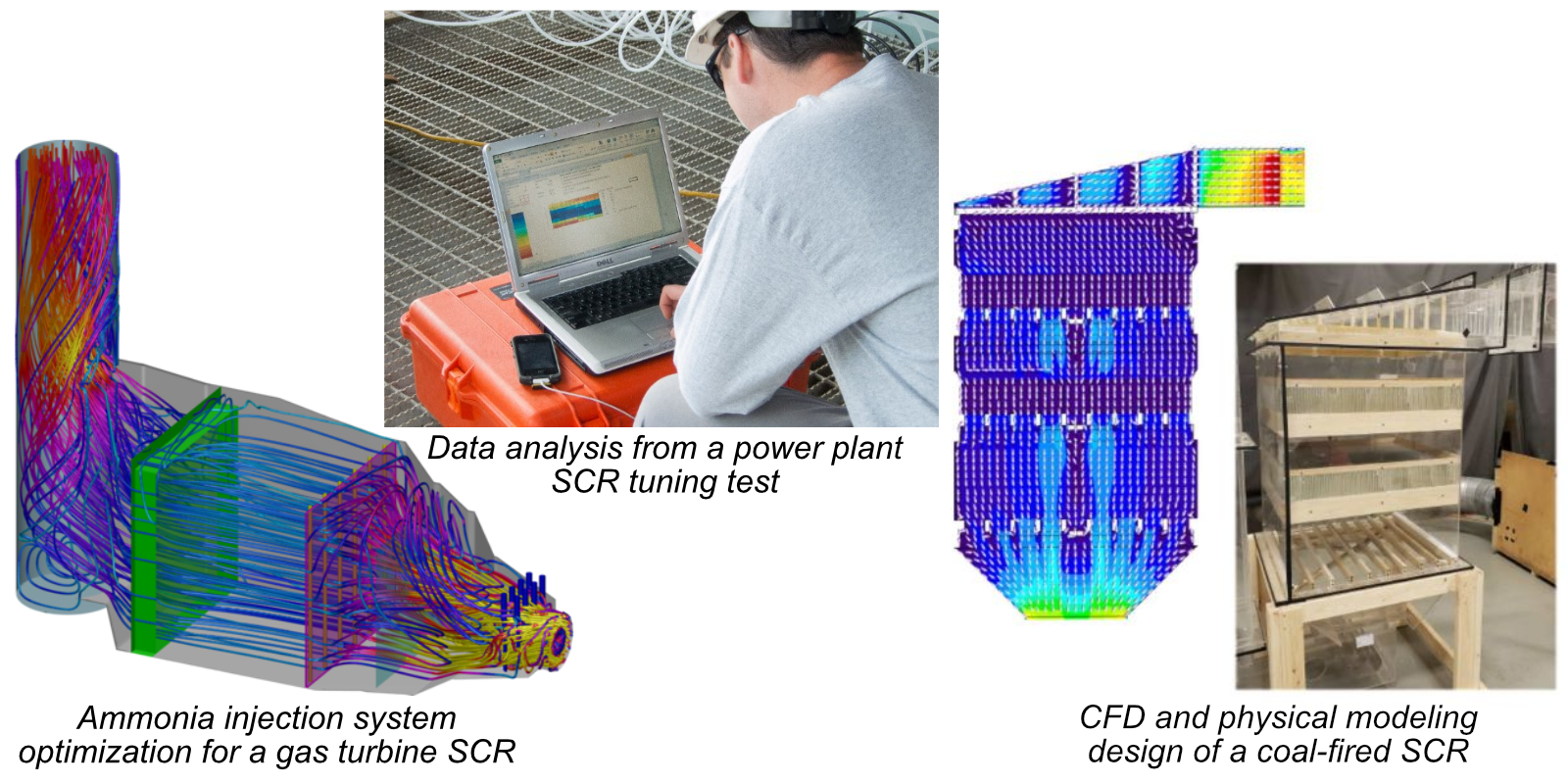
Examples of Airflow Sciences SCR optimization projects
Elecrostatic Precipitator (ESP)
An elecrostatic precipitator (ESP) uses electric charge to remove particulate from combustion exhaust. ESP systems are only effective if they maintain proper gas and particulate flow uniformity through the collection zone. A utility can invest a lot into a system like this and still have difficulty meeting their targets. We evaluate flow through ESPs via CFD or physical modeling and help establish proper flow control, bringing particulate removal up and reducing problems such as high opacity, spiking, and material buildup.
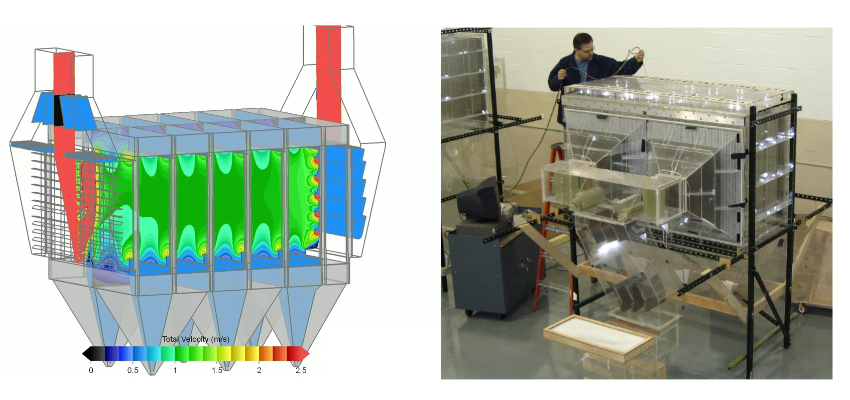
CFD simulation of flow through an ESP(left), and 1:12 ESP scale model testing (right)
Baghouse
Baghouses use a series of fabric filters to remove particulate. If flow becomes uneven, some filters are underutilized and others overutilized, allowing some particulate to remain in the flue gas. With flow testing or modeling, we can help restore balanced flow to each baghouse compartment and improve overall capture efficiency.
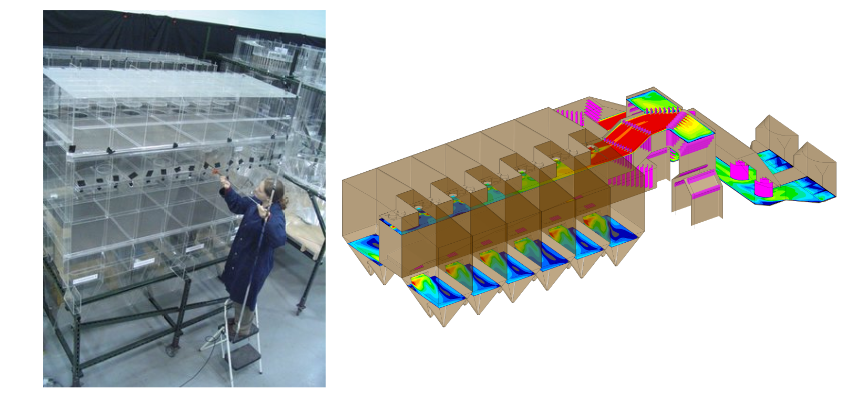
Scale models of a baghouse in the Airflow Sciences flow laboratory (left) and CFD modeling of compartment gas flow balance (right)
Airflow Sciences Provides Solutions for Reducing Emissions
In order to meet the standards of the Good Neighbor Plan, companies will need to employ multi-faceted approaches to pollution reduction. Airflow Sciences has been at the forefront of pollution control for over 45 years, with experience at every level of the process. We have the tools that plants need to fine tune their equipment and meet their environmental targets.
We provide a range of flow testing for pollution control equipment:
- Stack testing (Method 2/2F/2G/2H)
- Coal pipe testing
- SCR tuning
- Boiler tuning
- Inleakage testing
- Fan performance testing
- Combustion air testing (primary, secondary, and overfire air)
- Scrubber performance
- Iso-kinetic particle sampling (Method 5/17)
Other services we offer for power generation, refinery, cement, paper facilities:
- Numerical CFD simulation of all pollution control equipment:
- SCR
- Ammonia Injection Grid (AIG) and static mixers
- Boiler combustion process or components (detailed burner analysis, PA/SA/OFA)
- Electrostatic Precipitator (ESP)
- Baghouse / Fabric Filter
- Wet or Dry Flue Gas Desulferization (FGD)
- Calibration of measurement equipment (Method 2 and 2F probes, vane anemometers, hot wires, and more)
- Building and testing of scale models of process equipment
- Video or manned inspection of process equipment
With reliable flow testing and pollution control experience, we not only can give you an an accurate picture of your emissions levels, but we can also explore together the best ways for you to meet your reduction targets. Contact us today to get started reducing your plant emissions.
Learn more :
Visit our Good Neighbor Plan webpage
Watch our YouTube video on the Good Neighbor Plan
Airflow Sciences Corporation is an industry expert in pollution control and has presented and contributed on many technical topics that relate to process efficiency and remediation.
- Estrella del Mar III, a Visionary Floating Power Plant, Is POWER’s Plant of the Year
- Laboratory Evaluation of Potential Condenser Improvements
- Safe and Efficient Natural Gas Plants: Dispersion Tracking from Leaks, Vents, and Exhausts
- Flow Modeling as a Tool for WHRU Performance Optimization
- Flow Modeling: Boiler and AQCS with Dual Fuel Burning
- Ammonia Injection and Mixing Systems
- Improved Methodology for Accurate CFD and Physical Modeling of ESPs
- Flow Modeling and Testing of ESPs
- Extensive Planning, Innovative Work Strategies, Teamwork Combine for Successful SCR Project
- HVAC Exhaust Fan Modeling Improves Power Plant Performance
